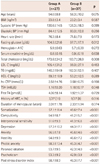1. Selye H. The stress of life. New York: McGraw Hill;1956.
2. Grippo AJ, Johnson AK. Stress, depression and cardiovascular dysregulation: a review of neurobiological mechanisms and the integration of research from preclinical disease models. Stress. 2009; 12:1–21.
3. Ghiadoni L, Donald AE, Cropley M, et al. Mental stress induces transient endothelial dysfunction in humans. Circulation. 2000; 102:2473–2478.
4. Spieker LE, Hürlimann D, Ruschitzka F, et al. Mental stress induces prolonged endothelial dysfunction via endothelin-A receptors. Circulation. 2002; 105:2817–2820.
5. Henry JP, Ely DL, Stephens PM, Ratcliffe HL, Santisteban GA, Shapiro AP. The role of psychosocial factors in the development of arteriosclerosis in CBA mice. Observations on the heart, kidney and aorta. Atherosclerosis. 1971; 14:203–218.
6. Strawn WB, Bondjers G, Kaplan JR, et al. Endothelial dysfunction in response to psychosocial stress in monkeys. Circ Res. 1991; 68:1270–1279.
7. Lawrence RC, Helmick CG, Arnett FC, et al. Estimates of the prevalence of arthritis and selected musculoskeletal disorders in the United States. Arthritis Rheum. 1998; 41:778–799.
8. Rozanski A, Blumenthal JA, Davidson KW, Saab PG, Kubzansky L. The epidemiology, pathophysiology, and management of psychosocial risk factors in cardiac practice: the emerging field of behavioral cardiology. J Am Coll Cardiol. 2005; 45:637–651.
9. Tofler GH, Muller JE. Triggering of acute cardiovascular disease and potential preventive strategies. Circulation. 2006; 114:1863–1872.
10. Pang KY. Hwabyung: the construction of a Korean popular illness among Korean elderly immigrant women in the United States. Cult Med Psychiatry. 1990; 14:495–512.
11. Park YJ, Kim HS, Schwartz-Barcott D, Kim JW. The conceptual structure of hwa-byung in middle-aged Korean women. Health Care Women Int. 2002; 23:389–397.
12. Celermajer DS, Sorensen KE, Bull C, Robinson J, Deanfield JE. Endothelium-dependent dilation in the systemic arteries of asymptomatic subjects relates to coronary risk factors and their interaction. J Am Coll Cardiol. 1994; 24:1468–1474.
13. Baum A. Stress, intrusive imagery, and chronic distress. Health Psychol. 1990; 9:653–675.
14. Corretti MC, Anderson TJ, Benjamin EJ, et al. Guidelines for the ultrasound assessment of endothelial-dependent flow-mediated vasodilation of the brachial artery: a report of the International Brachial Artery Reactivity Task Force. J Am Coll Cardiol. 2002; 39:257–265.
15. Derogatis LR, Meyer JK, Kourlesis S. Psychiatric diagnosis and psychological symptoms in impotence. Hillside J Clin Psychiatry. 1985; 7:120–133.
16. Kim KI, Kim JH, Won HT. Korean manual of Symptom Checklist-90-Revision. Seoul: Choong Ang Aptitude Publishing Co;1984. p. 1–39.
17. Boudrez H, De Backer G. Psychological status and the role of coping style after coronary artery bypass graft surgery. Results of a prospective study. Qual Life Res. 2001; 10:37–47.
18. Skydsbjerg M, Lunn S, Hutchings B. Psychosocial aspects of human immunodeficiency virus (HIV) infection in a pre-HAART sample. Scand J Psychol. 2001; 42:327–333.
19. Hwang JW, Hahm BJ, Kwon ST, Kim KH, Lee JR. Impact of lifetime subthreshold depression and major depression before internship on psychopathology and quality of life in Korean interns: 6 month follow-up study. Aust N Z J Psychiatry. 2008; 42:301–308.
20. Hardt J, Gerbershagen HU, Franke P. The symptom check-list, SCL-90-R: its use and characteristics in chronic pain patients. Eur J Pain. 2000; 4:137–148.
21. Becker M, Bilke E, Kühl H, et al. Analysis of myocardial deformation based on pixel tracking in two dimensional echocardiographic images enables quantitative assessment of regional left ventricular function. Heart. 2006; 92:1102–1108.
22. Chan J, Hanekom L, Wong C, Leano R, Cho GY, Marwick TH. Differentiation of subendocardial and transmural infarction using two-dimensional strain rate imaging to assess short-axis and long-axis myocardial function. J Am Coll Cardiol. 2006; 48:2026–2033.
23. Wittstein IS, Thiemann DR, Lima JA, et al. Neurohumoral features of myocardial stunning due to sudden emotional stress. N Engl J Med. 2005; 352:539–548.
24. Zaroff JG, Rordorf GA, Titus JS, et al. Regional myocardial perfusion after experimental subarachnoid hemorrhage. Stroke. 2000; 31:1136–1143.
25. Vita JA, Treasure CB, Yeung AC, et al. Patients with evidence of coronary endothelial dysfunction as assessed by acetylcholine infusion demonstrate marked increase in sensitivity to constrictor effects of catecholamines. Circulation. 1992; 85:1390–1397.
26. Mohri M, Koyanagi M, Egashira K, et al. Angina pectoris caused by coronary microvascular spasm. Lancet. 1998; 351:1165–1169.
27. Ako J, Kozaki K, Yoshizumi M, Ouchi Y. Transient left ventricular apical ballooning without coronary artery stenosis: a form of stunning-like phenomenon. J Am Coll Cardiol. 2002; 39:741–742.
28. Harris KF, Matthews KA, Sutton-Tyrrell K, Kuller LH. Associations between psychological traits and endothelial function in postmenopausal women. Psychosom Med. 2003; 65:402–409.
29. Adams MR, Robinson J, McCredie R, et al. Smooth muscle dysfunction occurs independently of impaired endothelium-dependent dilation in adults at risk of atherosclerosis. J Am Coll Cardiol. 1998; 32:123–127.








 PDF
PDF ePub
ePub Citation
Citation Print
Print




 XML Download
XML Download